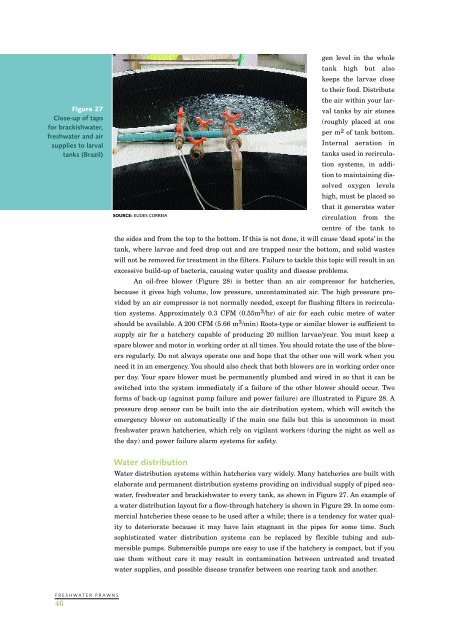Create successful ePaper yourself
Turn your PDF publications into a flip-book with our unique Google optimized e-Paper software.
Figure 27Close-up of tapsfor brackishwater,<strong>freshwater</strong> and airsupplies to larvaltanks (Brazil)SOURCE: EUDES CORREIAgen level in the wholetank high but alsokeeps the larvae closeto their food. Distributethe air within your larvaltanks by air stones(roughly placed at oneper m2 of tank bottom.Internal aeration intanks used in recirculationsystems, in additionto maintaining dissolvedoxygen levelshigh, must be placed sothat it generates watercirculation from thecentre of the tank tothe sides and from the top to the bottom. If this is not done, it will cause ‘dead spots’ in thetank, where larvae and feed drop out and are trapped near the bottom, and solid wasteswill not be removed for treatment in the filters. Failure to tackle this topic will result in anexcessive build-up of bacteria, causing water quality and disease problems.An oil-free blower (Figure 28) is better than an air compressor for hatcheries,because it gives high volume, low pressure, uncontaminated air. The high pressure providedby an air compressor is not normally needed, except for flushing filters in recirculationsystems. Approximately 0.3 CFM (0.55m 3 /hr) of air for each cubic metre of watershould be available. A 200 CFM (5.66 m 3 /min) Roots-type or similar blower is sufficient tosupply air for a hatchery capable of producing 20 million larvae/year. You must keep aspare blower and motor in working order at all times. You should rotate the use of the blowersregularly. Do not always operate one and hope that the other one will work when youneed it in an emergency. You should also check that both blowers are in working order onceper day. Your spare blower must be permanently plumbed and wired in so that it can beswitched into the system immediately if a failure of the other blower should occur. Twoforms of back-up (against pump failure and power failure) are illustrated in Figure 28. Apressure drop sensor can be built into the air distribution system, which will switch theemergency blower on automatically if the main one fails but this is uncommon in most<strong>freshwater</strong> prawn hatcheries, which rely on vigilant workers (during the night as well asthe day) and power failure alarm systems for safety.Water distributionWater distribution systems within hatcheries vary widely. Many hatcheries are built withelaborate and permanent distribution systems providing an individual supply of piped seawater,<strong>freshwater</strong> and brackishwater to every tank, as shown in Figure 27. An example ofa water distribution layout for a flow-through hatchery is shown in Figure 29. In some commercialhatcheries these cease to be used after a while; there is a tendency for water qualityto deteriorate because it may have lain stagnant in the pipes for some time. Suchsophisticated water distribution systems can be replaced by flexible tubing and submersiblepumps. Submersible pumps are easy to use if the hatchery is compact, but if youuse them without care it may result in contamination between untreated and treatedwater supplies, and possible disease transfer between one rearing tank and another.FRESHWATER PRAWNS46
















